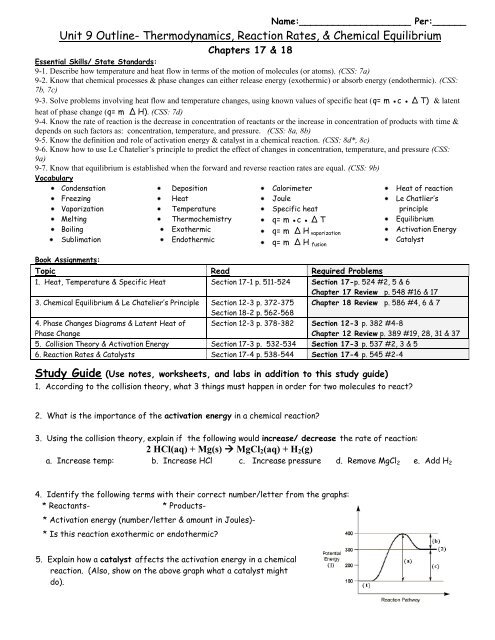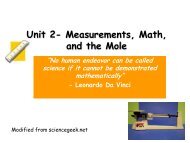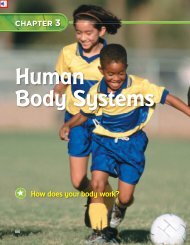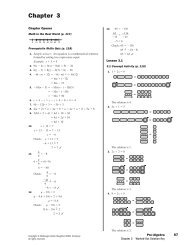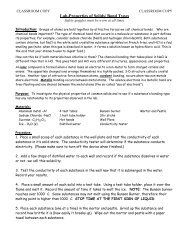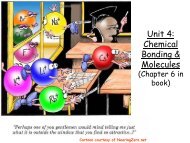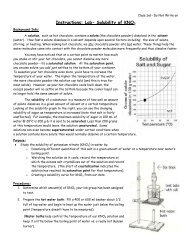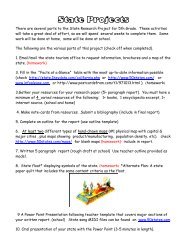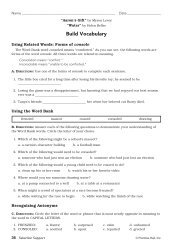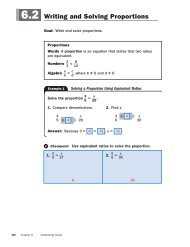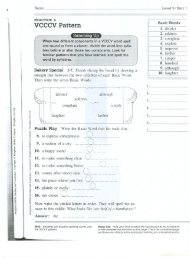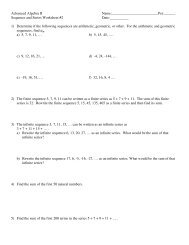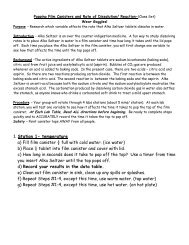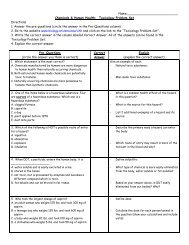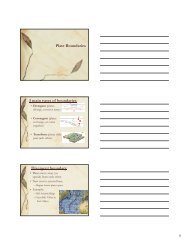Unit 6 Stoichiometry Study Guide
Unit 6 Stoichiometry Study Guide
Unit 6 Stoichiometry Study Guide
You also want an ePaper? Increase the reach of your titles
YUMPU automatically turns print PDFs into web optimized ePapers that Google loves.
Name:____________________ Per:______<br />
<strong>Unit</strong> 9 Outline- Thermodynamics, Reaction Rates, & Chemical Equilibrium<br />
Chapters 17 & 18<br />
Essential Skills/ State Standards:<br />
9-1. Describe how temperature and heat flow in terms of the motion of molecules (or atoms). (CSS: 7a)<br />
9-2. Know that chemical processes & phase changes can either release energy (exothermic) or absorb energy (endothermic). (CSS:<br />
7b, 7c)<br />
9-3. Solve problems involving heat flow and temperature changes, using known values of specific heat (q= m ●c ● Δ T) & latent<br />
heat of phase change (q= m Δ H). (CSS: 7d)<br />
9-4. Know the rate of reaction is the decrease in concentration of reactants or the increase in concentration of products with time &<br />
depends on such factors as: concentration, temperature, and pressure. (CSS: 8a, 8b)<br />
9-5. Know the definition and role of activation energy & catalyst in a chemical reaction. (CSS: 8d*, 8c)<br />
9-6. Know how to use Le Chatelier’s principle to predict the effect of changes in concentration, temperature, and pressure (CSS:<br />
9a)<br />
9-7. Know that equilibrium is established when the forward and reverse reaction rates are equal. (CSS: 9b)<br />
Vocabulary<br />
Condensation<br />
Freezing<br />
Vaporization<br />
Melting<br />
Boiling<br />
Sublimation<br />
Deposition<br />
Heat<br />
Temperature<br />
Thermochemistry<br />
Exothermic<br />
Endothermic<br />
Calorimeter<br />
Heat of reaction<br />
Joule<br />
Le Chatlier’s<br />
Specific heat<br />
principle<br />
q= m ●c ● Δ T<br />
Equilibrium<br />
q= m Δ H Activation Energy<br />
vaporization<br />
q= m Δ H Catalyst<br />
fusion<br />
Book Assignments:<br />
Topic Read Required Problems<br />
1. Heat, Temperature & Specific Heat Section 17-1 p. 511-524 Section 17-p. 524 #2, 5 & 6<br />
Chapter 17 Review p. 548 #16 & 17<br />
3. Chemical Equilibrium & Le Chatelier’s Principle Section 12-3 p. 372-375<br />
Section 18-2 p. 562-568<br />
Chapter 18 Review p. 586 #4, 6 & 7<br />
4. Phase Changes Diagrams & Latent Heat of<br />
Phase Change<br />
Section 12-3 p. 378-382 Section 12-3 p. 382 #4-8<br />
Chapter 12 Review p. 389 #19, 28, 31 & 37<br />
5. Collision Theory & Activation Energy Section 17-3 p. 532-534 Section 17-3 p. 537 #2, 3 & 5<br />
6. Reaction Rates & Catalysts Section 17-4 p. 538-544 Section 17-4 p. 545 #2-4<br />
<strong>Study</strong> <strong>Guide</strong> (Use notes, worksheets, and labs in addition to this study guide)<br />
1. According to the collision theory, what 3 things must happen in order for two molecules to react?<br />
2. What is the importance of the activation energy in a chemical reaction?<br />
3. Using the collision theory, explain if the following would increase/ decrease the rate of reaction:<br />
2 HCl(aq) + Mg(s) MgCl 2 (aq) + H 2 (g)<br />
a. Increase temp: b. Increase HCl c. Increase pressure d. Remove MgCl 2 e. Add H 2<br />
4. Identify the following terms with their correct number/letter from the graphs:<br />
* Reactants- * Products-<br />
* Activation energy (number/letter & amount in Joules)-<br />
* Is this reaction exothermic or endothermic?<br />
5. Explain how a catalyst affects the activation energy in a chemical<br />
reaction. (Also, show on the above graph what a catalyst might<br />
do).
6. Explain what is wrong with the following statement: “When chemical equilibrium exists, the concentration<br />
of the reactants and products remain constant and the forward and reverse reactions cease.”<br />
7. According to Le Chatelier’s principle, how does a system at equilibrium respond to stress?<br />
8. Use the Le Chatelier’s principle to predict how the system at equilibrium would shift to relieve stress:<br />
I. CO (g) + 3 H 2 (g) CH 4 (g) + H 2 O (g) + 113 J<br />
Stresses: a. adding CO b. Removing water c. Adding pressure d. Adding heat<br />
II. H 2 O(l) + heat H 2 O(g)<br />
Stresses: a. add pressure b. remove heat c. add H 2 O(l)<br />
9. Determine if the process is endothermic or exothermic in each of the following & why:<br />
a) hot pack (pack’s point of view) b) cold pack (pack’s point of view)<br />
c) H 2 + O 2 H 2 O + 483.6 kJ (heat) d) H 2 O + 483.6 kJ (heat) H 2 + O 2<br />
10. Label: a) the phase change names b) temperatures at which the phase Δ occurs<br />
c) endothermic or exothermic d) Amount of heat required for each phase change<br />
H 2 O (Solid) H 2 O (Liquid) H 2 O (Gas)<br />
11. a) What does temperature measure? b) Why can we use °C in this unit (vs. K)?<br />
12. a) What does heat measure? b) How is heat calculated & with what units?<br />
13. What are the 2 different things an object can do with heat energy when it’s absorbed?<br />
14. How can there be heat added/ removed during a phase change, yet there is no change in temperature?<br />
15. Water has a very high specific heat. What does that tell you about water?<br />
16. You are going to build a slide at a playground and your two option for materials are : Aluminum (specific heat =<br />
0.897 J/ g º C) or Iron (specific heat 0.449 J/ g º C). Based on their specific heat, which would you chose &<br />
why?<br />
17. Identify all the variables in the following equations & when you would use each equation:<br />
a. q= m ●c ● Δ T b. q= m Δ H vaporization c. q= m Δ H fusion<br />
18. Ammonia (∆ H Vap = 1371 J/g) & alcohol (∆ H Vap for alcohol = 841 J/g) are left out in an open container.<br />
Which of these liquids would turn into a gas faster? Why?<br />
19. If it takes 41.72 joules to heat a piece of gold weighing 18.69 g from 10 °C to 27 °C, what is the specific heat<br />
of gold?<br />
20. How many joules of heat are needed to change 30.0 grams of steam at 105 °C down to a liquid at 45 °C?<br />
Make a graph to indicate this change.


